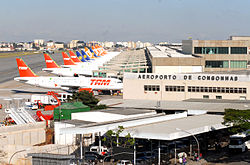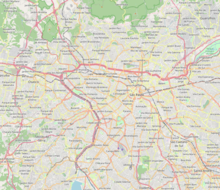São Paulo-Congonhas
|
São Paulo/Congonhas Airport Aeroporto de São Paulo/Congonhas |
|||||||||||||||
|---|---|---|---|---|---|---|---|---|---|---|---|---|---|---|---|
 |
|||||||||||||||
| Summary | |||||||||||||||
| Airport type | Public | ||||||||||||||
| Operator | Infraero | ||||||||||||||
| Serves | São Paulo | ||||||||||||||
| Hub for | |||||||||||||||
| Focus city for | Azul Brazilian Airlines | ||||||||||||||
| Elevation AMSL | 802 m / 2,631 ft | ||||||||||||||
| Coordinates | 23°37′34″S 046°39′23″W / 23.62611°S 46.65639°WCoordinates: 23°37′34″S 046°39′23″W / 23.62611°S 46.65639°W | ||||||||||||||
| Website | Infraero CGH | ||||||||||||||
| Map | |||||||||||||||
| Location in São Paulo | |||||||||||||||
| Runways | |||||||||||||||
|
|||||||||||||||
| Statistics (2016) | |||||||||||||||
|
|||||||||||||||
|
Statistics: Infraero
Sources: Airport Website,ANAC |
|||||||||||||||
| Passengers | 20,816,957 |
|---|---|
| Aircraft Operations | 213,043 |
| Metric tonnes of cargo | 49,231 |
São Paulo/Congonhas Airport (IATA: CGH, ICAO: SBSP) Portuguese pronunciation: [kõˈɡõɲɐs] is one of the four commercial airports serving São Paulo, Brazil (Campo de Marte Airport, Viracopos International Airport, São Paulo–Guarulhos International Airport being the other two). The airport is named after the neighborhood where it is located, formerly called Vila Congonhas, property of the descendants of (1767–1851), Viscount of Congonhas do Campo, first president of the Province of São Paulo after the independence of Brazil in 1822, during the Empire. In turn, the Viscount's domain was named after the plural of a shrub known in Brazil as congonha-do-campo (Luxemburgia polyandra, of the Ochnaceae family).
It is owned by the City of São Paulo, but operated by Infraero.
Congonhas has slot restrictions operating with a maximum of 30 operations/hour, being one of the five airports with such restrictions in Brazil.
The central hall of the passenger terminal is considered one of the most outstanding examples of modern architecture in São Paulo. However, modernizing and enlargement works conducted at the terminal from 2003 onwards, while trying to preserve the look of the older, historic section. Today the main terminal has 51,535 m2 (554,718 sq.ft.).
The airport was initially planned in 1919, but it did not open until 12 April 1936. The site was outside the built-up urban area at the time, and it was chosen because it had favourable winds and lay on a high hill with little vegetation. The airport was opened with a 300-metre (984-ft.) long dirt runway. In the beginning it was the private airport of VASP, built as an alternative to Campo de Marte which, already at that time, had operational difficulties. VASP started services to Rio de Janeiro on 5 August 1936, advertising two daily round trips of 90 minutes' flight time in each direction, starting a route that would eventually become one of the world's busiest. By 1957, the airport was the third busiest in the world for air cargo.
...
Wikipedia

